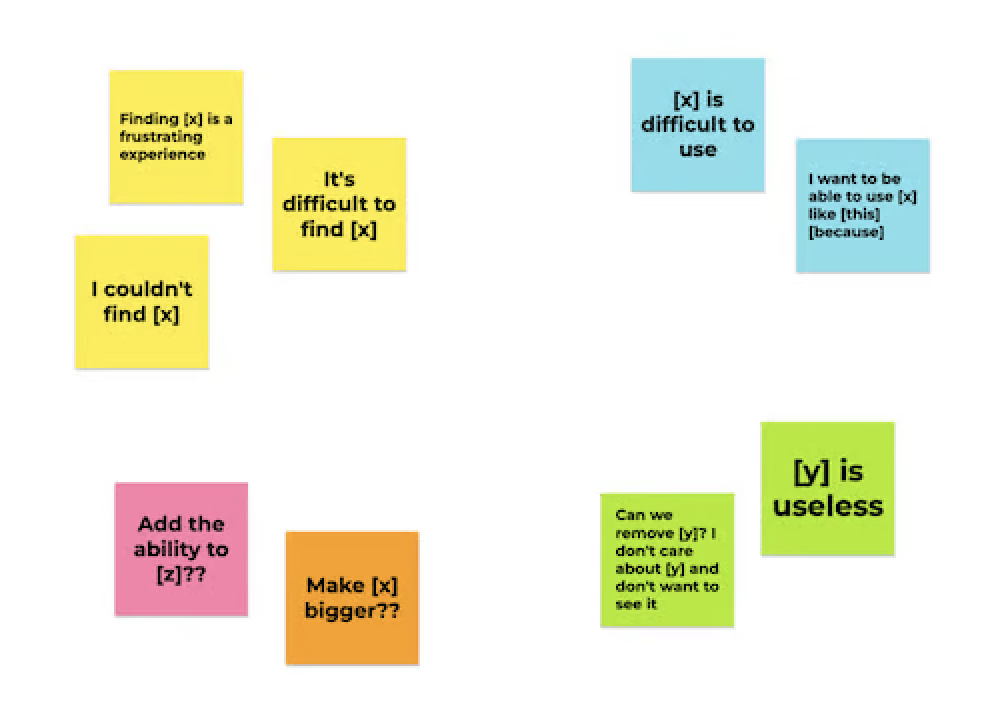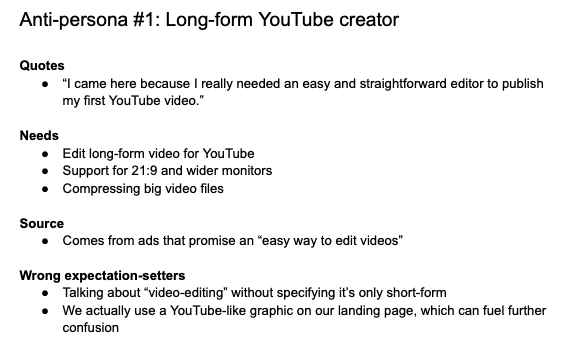The anti-persona: Learning from users who churn fast
We often talk about the importance of a user persona in UX design — sometimes even glorifying them as the most essential part of the process. And for good reason. Having a clear picture of who we’re designing for — and what their needs, goals, and expectations are — helps us create experiences that solve real problems for real people.
But what if, instead of building a persona of our ideal users, we also built a persona of the people we don’t want? An anti-persona?
It might sound counterintuitive, but it’s a powerful tool.
What’s an anti-persona?
An anti-persona is a profile of users you don’t want to attract or convert — those who churn quickly, get little value from your product, or even harm the business (e.g., by being toxic in a community).
If your product is attracting anti-personas, it’s likely a signal that your value proposition or communication is off. The issue isn’t just irrelevant traffic — it’s missed opportunity.
By attracting the wrong people, you dilute your focus and risk alienating the users who should be with you.
How to build an anti-persona
Creating an anti-persona follows a similar method to regular personas — just in reverse. Instead of figuring out what users who stay with you, benefit from your product, and are willing to pay have in common, you look at users who leave quickly and had wrong expectations from the very beginning.
1. Identify churned users
Start by identifying the group of users who churn fast — whether it’s general product churn, subscription churn, or any other churn that’s most relevant for your product.
I usually look at the bottom 20% percentile — meaning the 20% of users who churned the fastest in the recent couple of months.
2. Understand why they churned
Not all users who churn quickly are an anti-persona.
There might be the right people who joined for the right reasons and had the right expectations, but were disappointed with the quality of your product or resigned for any other reason. It’s essential not to confuse these two.
The post-churn interviews work the best. Identify how fast a user has to churn to be amongst the top 20% fastest-churning ones, and send these users an interview invitation within 24 hours of cancellation.
Keep in mind that since they are no longer invested in your product, their willingness to talk to you will be low. You need a high incentive ($50-100 usually works for 20-minute chats) and should be ready for a low acceptance rate (around 10%).
3. Segment churn reasons
Once you understand why people churn fast, group the reasons into two categories:
- Relevant — Issues your ideal users would care about (e.g., bugs, pricing, poor UX). These aren’t anti-personas, they’re people your product let down
- Irrelevant — Valid complaints, but outside your product’s intended scope. For instance, a short-form video editor might lose users expecting long-form editing. If long-form isn’t on your roadmap, those users were never your target
Group irrelevant reasons using affinity mapping to identify patterns and recurring themes:

4. Understand what sparked the wrong expectations
Let’s stick to the short-form video editor app example. If one of the main themes for quick-churners is the lack of ability to edit long-form videos, where does this expectation even come from?
If it didn’t surface during the post-churn interview itself, there are two more ways to uncover that:
- Expert evaluation — With this new information in mind, go through your product communication (e.g., landing page, onboarding, feature names) and try to understand where the confusion might come from. Maybe you are not explicit enough that it’s a short-form video editor? Perhaps the value prop is overly generic?
- User testing — Conduct usability testing and copy testing, and ask users to explain how they understand the product, who it is for, and what particular features do. Mark any mismatch between what they think the product is vs what it really is
5. Document the anti-persona
Collect all gathered insight and build a user persona the same way you would build it for your ideal customer. That is, include:
- A name (for quick reference)
- A photo (for memorability)
- Key quotes from interviews
- Their expectations and unmet needs
- Where they discovered your product
- Where their expectations went off-track
Unlike ideal personas, these don’t need to be overly polished — a simple Google Doc often does the trick. Look at my example:

Pro-tip — You might have more than one anti-persona, but don’t go overboard. Focus on one or two high-impact profiles.
How to use an anti-persona
Now that we have clarity on who anti-personas are, who churn fast, and why they come to the product in the first place, there are a few next steps we can take:
Evaluate traffic sources
Understand where anti-personas come from. It might be a case that out of, say, five channels users come from, most anti-personas come from a single channel. If that’s the case, you can reduce the investment and focus more on channels that bring you people more aligned with the target user persona.
Adjust messaging
When designing landing pages or onboarding funnels, get rid of the wrong expectation-setter, double down on messages that resonate with your target customers, and leave no room for confusion.
Expand the product (maybe)
If you notice that the number of people who fit a specific anti-persona profile is really high, you might consider starting to cater to their needs. For instance, if 25% of users want long-form editing, it might be time to support it — or launch a complementary product.
Do nothing
Lastly, if there’s no clear pattern (e.g., irrelevant churn reasons are very widespread) or only a small fraction of users fit the dominant anti-persona profile, then investing in further research and experiments is counterproductive. Just do nothing. There’ll always be some percentage of users who are not the right fit for your product.
Wrap up
Anti-personas are an intriguing and somewhat novel approach to understanding your users. By reaching out to users who churn fast, and then understanding:
- Why they churn
- What did they expect from the product
- What caused wrong expectations
You can develop a profile of a user that’s not a right fit, but mistakenly think they are — an anti-persona. This anti-persona can then help you evaluate your product and understand what’s going wrong. It might be:
- Using words and visuals that spark the wrong expectations
- Getting users from the wrong places
- Or even simply building the wrong product (if there’s a stronger demand for a different type of solution)
You can then use the anti-persona when thinking about the right copy, designing funnels, or even when prioritising new features (if you decide that you want to turn anti-persona into a target persona).
And if you’re exploring user personas more broadly, it’s worth looking into proto-personas — a useful technique for defining early assumptions about your users before you have much data. Together, proto-personas and anti-personas can bookend your understanding of user fit: one before launch, one after churn.
For more on how to talk to users after they cancel, check out our guide to post-churn UX — it’s a crucial step in building your anti-persona the right way.
The post The anti-persona: Learning from users who churn fast appeared first on LogRocket Blog.
This post first appeared on Read More


